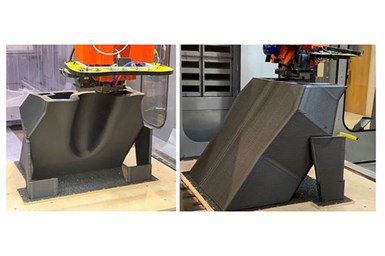Thermwood, Boeing, Navy Collaborate on Large-Scale Composite Tooling Research
Thermwood’s large-scale additive manufacturing (LSAM) machine was selected as the large-format additive manufacturing (LFAM) machine to conduct the technology development.
Share
Read Next

Composite cure tool printing on Thermwood LSAM.
Thermwood was a development partner in a Navy ManTech-funded program issued to Boeing Research and Technology (BR&T) to validate large-scale, composite additive manufacturing (AM) as a viable method for producing low-cost composite cure tooling technology with substantial time savings over traditional methods.
The program was managed by Advanced Technology International (ATI) for the Office of Naval Research (ONR) with funding provided from the Naval Air Systems Command (NAVAIR) Aircraft Equipment Reliability and Maintainability Improvement Program (AERMIP). Fleet Readiness Center East (FRCE) was a technical contributor. Thermwood’s large-scale additive manufacturing (LSAM) machine was selected as the large-format additive manufacturing (LFAM) machine to conduct the research.
FRCE provided a high-contour mold line surface to Boeing for generating the composite cure tool. The spherically shaped portion of the mold line offered the largest challenge, as the unsupported 3D printed angle limitation of approximately 45 degrees provides an obstacle to overcome for the spherical mold line section of the tool.
Boeing rotated the 3D print plane 35 degrees to avoid encroachment of the build angle limitation. The new build plane approach eliminated the requirement for temporary support material for the aggressive mold line shape. TechmerPM PESU CF 1810 high-temperature print material was used for the composite cure tool. Two interim support features were added to compensate for the center of gravity shift of the print. The LSAM machine performed flawlessly during the composite cure tool print, the company says. The tool was printed in 7 hours and 26 minutes using 610 lbs of material.
The composite cure tool was machined in 53 hours using the LSAM gantry router machine. The tool datum features and removal of interim members were machined prior to removal from the beadboard. The composite cure tool mold line part surface achieved a surface profile tolerance of .020” (+/-.010”).
The LFAM technology cost savings was estimated at 50% compared to traditional tool fabrication methods, and reduced tool fabrication lead time by 65%. The cost savings and tool fabrication cycle time reduction could provide enormous benefit to any organizations performing low-volume or custom composite part fabrication and repair, the group says.
Related Content
-
Next-Gen Horse Trailers to Be Built With Robotic 3D Printing
Double D Trailers is currently developing a prototype horse trailer that will be made with large-format additive manufacturing. The technology brings potential benefits for labor, weight and design features to this subset of recreational vehicles.
-
Savage Automation Delivers 3D Printed Commercial Manufacturing Aids
The company's approach to designing end-of-arm tooling and other devices has evolved over the years to support longevity and repairs.
-
Better, More Compact Radio Frequency Devices Through 3D Printing
3D printing technology company Fortify is applying its photopolymer process and material developed with Rogers Corporation to serve the expanding RF market.













